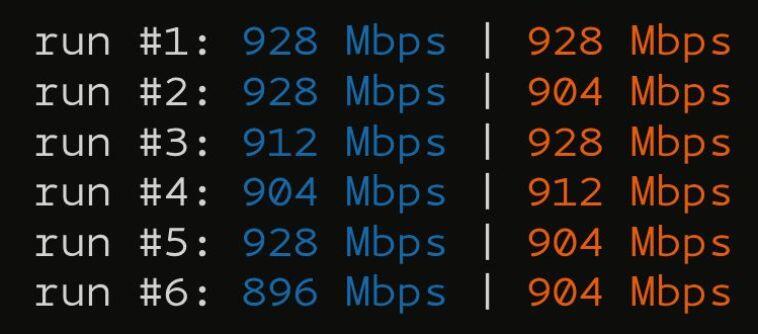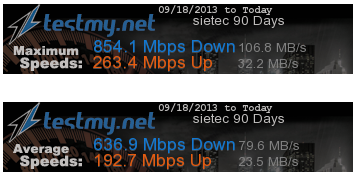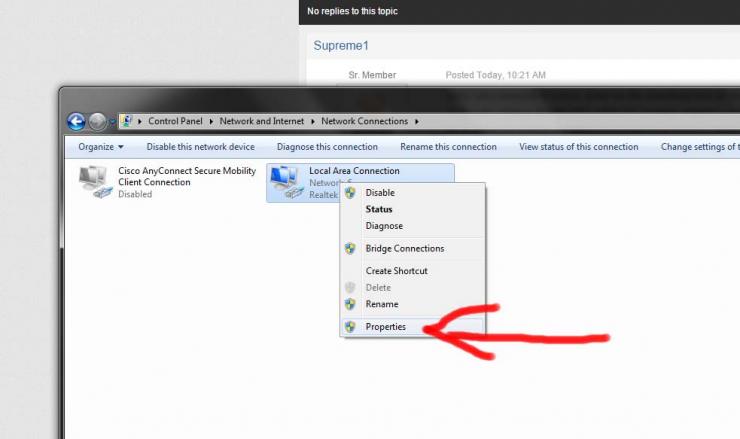Leaderboard
Popular Content
Showing content with the highest reputation since 01/31/2010 in Posts
-

New Members, Please Read!
Morrigan333 and 14 others reacted to CA3LE for a topic
First, if you don't plan on adding value to conversation... leave. Simple posts saying "hi" that contain no true value to the forum may be seen as spam and removed. Tell us something worth typing... share your speed, share your experience or tell me what you think of what I've built. As long as you're a real person posting real content you have nothing to worry about. Bots on the other hand don't last long here. We'd love to have you introduce yourself as a new member, so please click here to make a post to the New Members board that you're currently in. That way we can all give you a warm welcome and answer any questions you may have. But please, if you have a question about your system, connection or any computer related question please make those posts in the board that suits the topic best. If you don't know where your topic should go just post it to General Discussion and one of us will point the topic in the right direction for ya. To see a list of the boards you should make your posts to all you need to do is go to the Forum Default Page. Make sure you take note of the sub-forums that are with-in some of the forums. These sub-forums can sometimes give you more specific help. HAVE FUN DAMN IT! Most importantly... enjoy yourself here, this community is full of not only helpful self proclaimed (and proud of it) computer nerds it's also full of people having a great time! Many people become addicted to our forums so I'd just like to warn you... you may be with us till the day you die, but at least you'll make a ton of really kick ass friends along the way. - Damon15 points -
I have some new tools coming out! And I mean NEW! If you'd like to get an invite when a new Beta is available simply vote on this topic. Currently no ETA but development is moving quickly. I'd like people who are willing to provide feedback but it's not necessary. Just running the program will give me a lot of useful information.6 points
-
The most common question that people ask us is why their results here differ from speedtest.net. I want to explain something that may help you understand why this is. According to the Ookla Wiki [updated link] the following is true about your tests taken at speedtest.net... The fastest 10% and slowest 30% of your results are DISCARDED The remaining data is averaged together to determine the final result Throwing away the fastest 10% and slowest 30% of the results in my opinion does not make for an accurate test. Isn't THAT the data that you're here to see? Also note this isn't only true for speedtest.net. Ookla is huge, most of the speed tests online run their software. Source: wiki.ookla.com Multithreading makes your connection look better Ookla speed tests are also multithreaded. Meaning that they open more than one connection to the host and combine the speeds. This often can mask congestion issues. For instance, imagine that you have a pipe along your route that's limiting you to 10 Mbps. If you open more than one connection through that pipe you'll be able to achieve a faster speed... but testing that way will not clue you in that there is actually a problem along the route. Remember, you shouldn't have to multithread your connection to pull your full speed. Multithreaded speed tests, like the majority out there, are designed to benefit the Internet provider not the consumer. They often display your maximum throughput not your throughput over the course of an entire upload or download. Omitting the worst portion of your test resulting in inflated scores that may make you feel warm and fuzzy but aren't going to help you see and resolve connection issues. Multithreading can show that you're able to max out your connection by combining the speed of concurrent connections but a great connection can max out without having to multithread. So, if you have to multithread your connection to get your full speed, you should be asking why that is. With TestMy.net it's instantly apparent if there is a congested route. Your speed here reflects the actual loading time of data within your browser... not the combined efforts of multiple threads being altered (dropping the top 10% and bottom 30% of the results) and added together, all through a plugin that isn't suited for the task. :: EDIT :: If you'd like to multithread with TMN, I offer that as well. Try the multithread speed test. TMN's multithread test gives you the option to select from an array of servers. Allowing you to test across multiple routes, to more than one server at a time. TestMy.net is the only Internet speed test with this ability. So THAT'S why your results differ. -- TestMy.net is a harder test to ace and a lot less forgiving than other speed tests. But isn't that what a benchmark should be? :: EDIT :: Another thing to consider is if you're running windows, particularly if it's older than Windows 7 you may need to tune your TCP stack to see your full speeds. Windows doesn't always come out of the box optimized for fast connections. Flash based speed tests fail to detect this problem. To make this change for free I recommend TCP Optimizer. This makes changing those settings very easy and nearly fool proof. Just open it, slide the bar over to your speed that you're supposed to have, check "modify all adapters" ...apply the settings and reboot. You should have faster speeds after your re-test if that was the problem. Here's an outside source talking about exactly this issue, I'll hunt down more examples. >> Download Speed Test - Something fishy? A few related topics :: Accuracy.. Slow upload, drastically different from other speed tests Resuts Vs. Actual Download speeds? TestMy.net shows different results than other speed tests TestMy v Ookla Difference Between Speed Test Sites? Satellite Service Testing Locking at around 14Mbps Questioning speedtest.net resolved with TestMy.net Outside Sources :: Internet providers caught inflating speed test results [myce.com] Use Testmy.net or else!! NO MORE speedtest.net posts will be allowed!!! by the Admin on [xplornetsucks.com] Accurate Speeds Or Speed Test Error? on [wildblueworld.com]6 points
-
I have A LOT of upcoming releases, many of which are going to be built around a new concept. Because there is so much core programming being changed I'm going to do something I've never done. I normally work on the site live and things are released as I write them... if your in the right place at the right time and you pay enough attention you can see me building sometimes. Well, I really feel that the version I have out right now is INCREDIBLY stable... I don't want to disturb any testing or use of the site. So I'm going to offer a beta program for those who wish to join. To join, vote Yes on the poll above. I'll add you to a special member group and you'll be emailed with updates. You'll also have an option in your menu that will allow you to switch between beta and release. Smaller updates will be globally available but the major ones will be held back for the beta testers to play with first. This will help find bugs before public release. When I'm satisfied with the code I'll offer an option for a while to the general public to turn on the beta... after general public beta testing I'll then release it to the final. We'll then start the whole process again for another round. This is going to be really hard for me to do, I really hate to hold new stuff back. But maybe doing it this way will help me spend less time on bug checking and more time of actually building. I'm one person. Your help with this is appreciated. Everyone who has ever submitted a comment... you've already helped build this site. I started with a vison but you guys expanded it. If I'm going to keep bringing those ideas to paper I really need your help. I have at least a couple thousand hours of programming planned just for the next 3-6 months. I need to use my time effectively, spending hundreds of hours searching for bugs is not using my time wisely. Register (If you haven't already), vote yes above and I'll email you later when I have more information. Then, you can tell your friends that you helped build this site. Thanks -D6 points
-

Don't trust, verify. I'm giving you ways to verify.
The Speedtester and 4 others reacted to CA3LE for a topic
My beta gives anyone the ability to run TMN on any computer they'd like. Run it locally on a Docker images I've prepared for you or install it on any web sever, with or without SSL. It only takes 2 files, a total of 1800 bytes of code on your end. What speed will you see between two wired 1 GbE? Exactly what you'd expect to see, watch for yourself. tmn-on-my-server.mp4 The Mac and Windows machines are fairly distant, non-direct routes. The connection traverses 2 switches, then the router, then another switch also adding in about 100 ft of cable before it arrives. Not lab conditions, I wanted all of those real world variables. If you inspect I think you'll agree, TMN's results are pretty exact. tl&dr So average 916 Mbps | 904 Mbps. Adding 6% network overhead you get to 971 Mbps | 958 Mbps. Which is right in line with what we see coming across the interface in reality. I did the same LAN testing when developing the current version (v18) you're using now, always do. But now I'm giving the ability to do it yourself, super quick. ... I've also done that before but not like this. This is very different. Cut and paste a few commands into Terminal or PowerShell and you're running local tests on all your devices in a few seconds. You can also audit all of the code and understand the entire container in just a few seconds. Pretty excited to share that with you all. Curious how people will use it.5 points -
Different download speed in Laptop and PC
Libby the Kid and 4 others reacted to JereSalo for a topic
Hi! Thank you both for your help. I solved this issue 2 days ago, I had a problem in my Windows 10 desktop and I investigated it for a few days till I found this: https://stackoverflow.com/questions/10694244/sending-data-from-windows-is-slow-over-any-network-with-high-latency-but-linux-i I wrote this on my CMD: netsh interface tcp set global autotuninglevel=normal And it worked! Now if I run the test on my desktop pc I have more than 30Mbps and before I had 3. I don't know why Windows was configured in that way. Have a nice day and thank you for your time!5 points -
Connection is:: 5801 Kbps about 5.8 Mbps (tested with 12160 KB) Download Speed is:: 708 KB/s Tested From:: http://www.testmy.net/ Bottom Line:: 104 times faster than 56K you can download 1MB in 1.45 second(s) https://testmy.net/cgi-bin/get.cgi?Test_ID=HA7PXKR5N I have Roadrunner Premium rated at 6mb down and 512kb up , I pay $60 a month , Anyone that has faster and pays cheaper????????5 points
-
I was supposed to have ping included in the last version but I didn't get to it. I'm hoping to put that up front and center in the next release. Keep visiting to watch it develop before your eyes. --- I'm far from finished.5 points
-
Hi all, I just wanted to put my two cents in here for what it's worth. First of all, I have no interest in any online speed test. I host mirrors for the two most popular speed test sites, one of which you are on right now. My only interest is in helping people get accurate and informed information when it comes to measuring their internet speed. I will probably upset some people with this post, but what I am saying comes from my 12+ years of experience in tweaking web servers and meticulously measuring the details of different transports. For http (e.g. "internet" or web-browser compatible) speed testing, I can say with 100% certainty that you will not find a testing methodology more accurate than testmy.net. The attention to detail and every little tidbit of information involved in http/tcp transport is second to none. I can say that since I host a mirror on here and can measure the results from both ends. For example, if you make a request on my box, apache keeps a log of the transfer information and precisely how long the socket was open and how much information (exactly) was transferred. The timing is accurate to less than 1/10000 of a second. Therefore, I can measure the precise time it took to transfer, say 100MB from my box to your computer and determine from that the speed in which the transfer took place. TMN goes a bit further than most, in that you can see the actual speeds during the xfer as it fluctuates. The other speed test engines take an average of your speed over the duration of xfer and throw away a significant amount of the data as "erroneous." My question is, if it is erroneous yet contributes to the overall time it takes to transfer a file, it is NOT erroneous and should NOT be discarded as such. This is where you will see significant differences on the "other" sites. Sometimes it is disappointing to see the real numbers your machine is capable of. Believe me, I know. I get upset when I think a measurement is wrong. But, it gives me valuable insight into how to increase the throughput and achieve better results. Take a look at my max and averages These come from my VNC (e.g. linux remote desktop) connections to one of my boxes using Firefox or other browsers to test the box. The average has been skewed by testing all kinds of different settings (e.g. jumbo frames, different MTUs, browsers, servers, etc) and so could be much higher if I dedicated an account singly to testing with my best settings...but that would kind of defeat the purpose, in my opinion! If you consider the overhead on the processor and network interface just to support my 1920x1080 VNC connection, then factor in that I am remoting into a server to test it's connection; furthermore that it is just a TCP link with limited threads that can be opened (due to the nature of the protocol), my box is capable of much more. But when it comes to true INTERNET ability, I have never measured anything faster than I can through testmy.net. Consider that the "other" sites use Flash and other visual enhancements, a limited amount of data and basically, nondiscriminatly discards data assumed to be erroneous, which site do you think will be more accurate? I will soon be starting a blog regarding how to improve you internet connection speed and will post the link when I publish it. I would like people to try before and after modifying system settings as well as the other speed test sites. I say everyone should try the other sites as well and see where the discrepancy lies. But if you are truly looking to improve your performance, in my opinion, you have found the spot (that is, unless you want to write your own code and try to start from scratch what has taken a decade to get where it is...good luck by the way). Anyone with questions, please feel free to ask. Understand, please, that I am often distracted and cannot immediately reply -- but I will reply. Probably your best source of information is in the threads on this site, or directly from Damon. He is very active on his site and generally answers anyones questions or posts fairly rapidly. Thanks for reading and forgive my spelling and/or rambling! Good luck! SIETEC5 points
-
I hope everyone enjoyed Family, football and food. Peace4 points
-
4 points
-
Hi all, just passing along my experience - your mileage may vary. I think its worth submitting since I was able to double both my UP and DOWN test speeds with these small changes. These observations were made with an ASUS AC-3100 Router, from a hardwired 8p 24 gig (mem) server with a 1 gig Ethernet card. Firewall off I understand this is religious, but I set the devices to protect themselves as best I can. After all, I had no firewall rules in place anyway. So the firewall was just kind of a big piece of code in the router that had to do work on the packets - slowing the router down significantly. IMO that protection can be done elsewhere for much less expense in speed. Again, broad stroke firewall (even with no rules set) does protect against certain attacks - so turning it of is a choice I gamble on since I'm not the department of defense and nobody is trying to prove anything by screwing me over. AND, my server firewall does the same stuff regarding DoS attacks and what not. ( all these fear factors we live with ) NAT Acceleration (cut through) on NAT is a confusing thing to investigate. Devices, L3 switches, routers all have settings. I'm still reading about it. However for today, I can tell you that NAT acceleration ON allows a bunch of stuff to bypass the processor in the router and it makes a HUGE difference in Download speed. Turning it on or off did not make any difference in Upload speed. DNS Settings Talking about DNS settings arrives at a discussion of DHCP settings. That is because DHCP does you the kind favor of loading up the address of it's favorite DNS values when you do not tell it otherwise. This is the setting that allowed me to get from about 5Mbps Upload to 20Mbps Upload instantly. I was initially using the ISPs DNS server, and had my router set to allow DHCP pass through so my devices were becoming contaminated with the ISPs DNS address. This is a tricky topic but it makes a big difference. Consult your manuals carefully. Bottom line, do what is needed to get a good DNS server working for you. --john4 points
-
Hey all. Just wanted to say a big thank you to the creators and maintainers of testmy.net. I live in Jamaica and we don't have fast or quality internet service here unless you live in the more populated areas. Where I live there are no physical internet connections available so I've had to use fixed wireless options for years. I've been through every single one that's been available and your speed test has helped keep my sanity. Basically all of them have tried to send me to the sites that make them shine and make me look like the crazy unreasonable customer. My current provider just upgraded my package after almost 15 years and wanted me to do daily speed tests to make sure everything was fine. They told me to use openspeedtest.com and I told them I would use testmy.net instead (been using you for years and loving it, THANK YOU again) but they said they wanted to measure jitter as well so I relented. Well, after a while I noticed the connection was acting up and while testmy.net gave me the real world, openspeedtest.com was giving results saying I had full speed and nothing was wrong. To cut a long story short, after 2 months of telling them something was wrong and trying to convince them to use testmy.net instead, they have finally relented and admitted there's a problem on their network. So thank you again to each and every one of you who has and anything to do with this site. Please continue to do what you do and fight for the little guy. Much appreciated.4 points
-
Different download speed in Laptop and PC
JereSalo and 3 others reacted to 28mufields for a topic
Thank you JereSalo! this works for me too. only one of my PC has a slow speed, I been looking for the reason for few month, but you solved my issue!4 points -
Wow... look at this test result. I pay for 400 Down and my Avg Down is around 448. I snuck one by their speed throttle mechanism. At least now I know my neighborhood and facility wiring etc. can handle 1 gig. How this happened I don't know, but here is my theory. Based on the last thing I did, which was manipulating my so called router to grab it's Ip address from the host's DHCP but ignore everything else that comes from the Host's DHCP -- my router finally picked up DNS from 1.1.1.1 I proved my so called router was using the new DNS server via the cool tool on this site (DNS lookup or something similar, under Misc --> tools). So, the very first time I ran the test without the extra DHCP baggage - my Down test hit 1 gig+, but their clever infrastructure caught on real fast. At first it over-corrected, then settled down in at the speed I usually get in my test results. So, no, benchmarking is not my hobby. I just want to be well prepared for my inevitable conversation with my dear old ISP.4 points
-
4 points
-
I was once a Hughesnet customer and had the same problems from time to time. It is shared bandwidth; therefore, the more devices added, the less bandwidth you receive. It's a normal practice for Hughesnet to "oversell" available bandwidth. I've also known quite a few people with the service and they all report the same problems. Once their 30 day trial period ends and their contracts are locked in, the service they receive after that point is poor to say the least. It's as if they give new customers "PRIORITY" access until the trial ends, and then, BAM, customers find out exactly what they're paying for. You are not alone! There are thousands upon thousands of complaints filed against Hughesnet for their business practices.4 points
-
Distance issues?
deborah carson and 3 others reacted to fey42 for a topic
Your problem might not be your local ISP. Since they have to connect across the country you are at the mercy of every connection made and every node you pass through. They have control over everything until they hand it off to the Internet backbone and then all bets are off, It can go anywhere. I live 70 miles south of Portland, but to get to the Portland Netfix server, I go though Seattle and sometimes San Jose. Also you have time of day that affects speed. Imagine as everyone comes home, has supper and kicks back to stream their favorite show. It starts first on the East Coast and the load picks up as you move West. 7PM is the worst, the whole country is streaming and unless the server is in your back yard you are in trouble. Try your test against multiple test sites and time of day. You will see a wide variance the further away you are from "home" and the time of day.4 points -
No problem, glad to help. Thank you too. I sell advertising but try to not over do it. Huge segments of TMN's traffic never even see an ad. ISPs and other entities have offered to pay for analytics, many times. Instead of just giving them what they want I'm building TMN to do it for me. Instead of sharing the information with only those who pay for it TMN aims to share all of its collected information with everyone, for free. (within the privacy policy guidelines of course) -- with help from those requests the information presented here will become more and more detailed in future versions.4 points
-
SIETEC's quick, short & simple tips
shark91962 and 3 others reacted to sietec for a topic
I will preface this post by saying that I am a Windows dummy, so I don't have a whole lot to offer to the Microsoft bunch out there. However, my quick little tips don't apply so much to a particular OS as to general system settings good for almost any OS, so here goes: 1. Minimize the amount of running services on your system. I cannot overstress the importance of this one -- the more services & applications you have running simultaneously on your box, the more overhead utilized. So many people have all kinds of virus scanners, supposed "speed up" apps, unnecessary running services/daemons/etc. which do not need to be running 24/7. For instance, say you have a virus scanning platform. **Please note, I am not advocating that you turn off your virus protection -- and only you can determine the level of protection you need, so in the end, use your own judgement and don't hold me responsible (please) ** Anyway, virus scanners are generally not needed constantly. You're not going to get a virus if you don't have one already and you are not downloading files, visiting malicious sites or running untrusted software. There are times the preceding statement if false, but rarely enough to cause concern. So, I suggest that you only have your virus software set to scan files on demand - e.g. when you download something or when you are reading emails. Use your browser security settings to help minimize the chance you wonder into an insecure site and always make sure the sites you are using for sensitive information (such as bill payment, purchases, sensitive data, etc) are encrypted with trusted encryption (check the pad lock icon and make sure it is a "https" connection). Using your browser to help with security is a performance sparing method to minimize the processor intensive constant scanning by a virus detection package. If you have a ton of system services running in the system tray of Windows, take a look at which ones you really need and eliminate the others. Same for system startup -- clear out everything that does NOT need to be started upon startup; this will save memory (RAM) and processor usage...which leads to quicker page response and transfer speeds. Advanced users should check actual "services" in Windows and turn off those you don't need. If you're running a linux flavor, I assume you're already pretty versed in modifying your configuration. If not, PM me. e.g. . chkconfig --list to see a list of services or service --status-all to see what's running currently (RH/CentOS/etc.) 2. Change your MTU (max transmission unit) to 9000 if you're on a high speed cable or ethernet link. This allows your network interface to send much larger frames than the standard 1500 value. Basically, this parameter sets how large a single transmission frame may be, minus overhead. So, if your system includes overhead in the setting, set it to less than 9000 so you don't get an error for exceeding 9000 (e.g. set it to 8900 to be safe). Just make sure you do this if you know what you're doing only and if you're sure it is appropriate for your set up. It shouldn't cause any problems, but make sure you know how to get back in there and change it to the previous value in case it breaks your connectivity (which I doubt!) 3. Try different browsers - not only are some browsers actually much better at speed natively, they save on system resource usage as well. My suggestion: firefox or opera. I was never a fan of opera until recently when they made a lot of improvements. Firefox is always a good choice. IE would be my last choice, but many people love it. Chrome is pretty good too but I have noticed some issues with it lately. 4. Stop background file transfer daemons such as online data backup utilities, cloud sync systems (iCloud, etc). If you have things like that running in the background, they obviously will take a lot of your bandwidth away (unless you specifically configure them not to, they will use as much bandwidth as they can get their hands on). So, shut down iCloud from syncing while the system is active and if you use something like Carbonite backup, let it work when you are not using your box (e.g. overnight). 5. If you are using wifi, make sure you have a good signal and make sure you are using the faster encryption settings. You should use 802.11g at a minimum and preferably 802.11n for best connectivity. Most network connections (note I said most) will not realize much (if any) performance gain by going direct ethernet unless the previous 3 suggestions (signal, encryption, protocol) are not followed. If you cannot adjust the first 3 settings, then you probably should connect directly to your router's ethernet connection or to your cable modem/DSL/etc. You can also change the "power" or "energy" saving settings on your wifi box by setting the transmission power to 100% all the time. Search your manufacturers KB or google for "increasing wifi transmission power" or, more generally, "tutorial to speed up wifi" Note that wifi is going to give you a theoretical maximum of 450Mbits per second in the best and hardly ever realized conditions. Generally 300Mbits is as fast as you'll see and if you're not using 802.11n, 54Mbits optimum. These optimal speeds are what the manufacturers tout, but it is nearly impossible to see them. Believe me, wifi can interfere (pardon the pun ) with even a moderate cable speed of 30-40 Mbits/second. Summary: wired is always better, but there are ways to maximize your wifi connection. I will put the last 5 of my first 10 tips online over the next few days ... but, please feel free to reply to this post or PM me if you need help doing these things. I hope some of this helped! SIETEC President & Lead Network Engineer SIETECserverNet :: sietecFASTcom :: sietecMATRIXcom Coming soon, I will be launching a hosting service unlike anything you have ever seen -- take a look at my test results here: My clients will be able to achieve similar, depending on the service chosen, and it is my goal to help them do so. Interested in pre-sales information? Drop me a line at [email protected] and let me know what you are looking for ... deep discounts to the first 25 people! My website is being re done right now, but I basically offer anything most hosting companines offer, just in a virtual box. (which, believe it or not, that is how I achieved most of these results, through one of my virtual machines). You still get to pick how many processors, RAM, type of HD and space on disk, NIC speeds, etc. You can even choose a free virtual appliance that suits what you are doing and launch it on my platform. Or, I can assist you in installing your OS and let you take it from there .. full root/administrator access! Again, if interested, email or PM me!4 points -
Hello!
j7n and 3 others reacted to paroxysmal for a topic
@CA3LE --Thanks for the great speed test site. I was genuinely surprised at the results I got here compared to speakeasy/ookla. My ISP does host an ookla site and does recommend using the java based speed tests. I was having trouble after upgrading my internet package. My old one was 10Mb/768k and I upgraded to 30Mb/3Mb. I had asked the sales/accounts lady if I needed a new cable modem and she said no and I believed her. Well after doing multiple tests on various sites i stumbled upon testmy.net and actually got an accurate result for what my connection really felt like compared to what my ISP said it should be. I contacted tech support and they said that I did need a new cable modem that the upgraded plan required a DOCSIS 3 cable modem and I had a DOCSIS 2 modem and that could/would account for variances in speed vs internet package. I went in and swapped out cable modems free of charge and tests were about the same on ookla/speakeasy but improved by a decent amount on testmy.net. Most importantly it felt quicker and more responsive as my family and I were using it for various things. Thanks again and keep up the good work! Oh and for all you older techies in the crowd that might remember how we used to do speed tests before there were websites for it *grin* ftp blah.soandso.edu get 5mbfile.tar.gz send <1mbfile.tar.gz --paroxysmal4 points -
That would not solve the issue, and would essentially give you a single average number that is better left as a set of numbers for more information regarding routing. There are two speed graphs that I think are most important for an internet connection: a graph of speed tests to an internal server (within the ISPs network) to determine the average and variance during the day/week/year/millennium of your connection to your ISP; and a graph of speed tests to a server outside the ISPs network, to find out how good your ISP is at handling that. Latency tests can also be very useful. You are right in that a single server can be hampered by a single bad network, but it does point to a problem that is not supposed to exist, and will affect many more servers which you want to interact with.4 points
-

How I helped my speed.
Jessica Coffey and 3 others reacted to BillCherryAtl for a topic
Hi Guys I thought I'd post a solution to a problem I had recently - it might help someone else. Last year I was getting 30+ Mbps down with Comcast using their "Boost" option (costs a bit more than regular). Then this year, it dropped to 10Mbps. Of course I complained to Comcast, ran all types of scans, checked my PC with HighjackThis, etc. Nothing. I have a Dell XPS with a mother board capable of handling 24GB of RAM. I had 15GB in it but then took out a 1GB stick to put in a 4GB stick giving me 18GB of RAM. I also have a bootable second hard drive "F" with Win 7 Ultimate but my primary "C" dive has Win 7 Home Premium. The puzzler is the secondary "F" drive was still getting more than 30Mbps down but the primary "C" drive was only getting 10 Mbps. What's up with that? I tried everything until I discovered that Windows 7 Home Premium can only "handle" a maximum 16GB of RAM - Win 7 Ultimate can "handle" 192GB of RAM. When I dropped my RAM back to 16GB my speeds returned to above 30Mbps on the primary C drive. The lesson for me is that if you put more RAM in your machine than your Operating System can handle, you might down grade your speed when you think you're helping.4 points -
3 points
-
3 points
-
Hi I only recently found testmy.net, and I'm actually blown away that this site isn't a subscription service or running ads. Can everybody stop for a minute and appreciate this? My account is only a couple hours old so I've only really just begun to use the app, but it is very clear to me the amazing value you are providing. I'm a software/web developer by trade and have enough familiarity (far from an expert but not a babe in the woods) with whats going on under the hood here to be impressed and grateful for a diagnostic tool of this scope. I have some questions though. I hope you don't mind. 1) I was reading through the FAQs about speed test inflation from other services to benefit the ISP providers. I noticed the posts are dated 2012 so I'm curious about the current state of these matters. For instance, flash is dead. Surely, people can't still be using flash for speed tests can they? This is a big broad question, but what is the current landscape for speed tests and do you still see the type of collusion between tests and ISPs describe in the FAQ? 2) In tandem with the above: Since the time of those posts, have any other speed test tools come around that are reliable, in-depth, and don't inflate stats? 3) How is this site funded? With so many servers offered, an active user base eating up bandwidth with tests, server space for the database and software code, and the investment in maintaining this app costs are bound to stack up. 4) This question is a bit tangential to the above and outside of the expertise displayed by the tools here, but I'm going to throw it out there anyway. Is it theoretically possible to create a testing tool for LTE equipment (4g/5g reliant devices) that diagnoses a device's connection to cell towers in an analogous manner to testmy.net's diagnosis of internet connectivity issues? I have been working with SIM card accepting routers, CAT 12 modems, Goldenob firmware, and parabolic antennas to connect to cell towers recently and I would kill the pope's brother for a comparable tool. Diagnosing connectivity between the hardware and the cell towers can be a face-shreddingly grueling process, sometimes lasting months. Even in the best cases its decently involved. Judging by the forums, people aren't always happy you're telling them their connection is slower than they thought. So, thanks again for doing this sometimes thankless work.3 points
-
Yes... and no. You still need to shoot me a PM, just say, "I'd like to change my username to ___________". I have a program on my end that queries the database and outputs manual SQL commands that I then run against the database server. I input two (before / after) usernames and it gives me all the commands to run to make the change... cut 'n paste from there. It's a much quicker process than before but I'd still like to make it automated. At most a few people a month request name changes, if I get more requests it will justify the time expense it will take me to make it fully automated. So shoot me a PM if you'd like your username changed.3 points
-
I feel like people often mention their ISP by name. But you have to admit... you just made your first post here and haven't told us who you're with. ? We can see you're on Comcast with a little research... https://testmy.net/compID/160108503386 I'm with Comcast too. But we have vastly different results. Please name them by name. I encourage everyone to speak freely. If you don't like what your ISP is doing, we want to hear about it so that it might help others in the future. We also want to hear about positive stories as well, those help consumers make informed decisions just as much. "Earning Trust" is for members who haven't made enough posts to rank up yet. There is also post moderation for the first few posts you make. After that you're more free here. You can thank the spam robot plague for that one. That moderation is really only for that reason. Humans tend to follow the rules here. So anyone here with over 2 posts (since about 2012) has gone through the human approval process. Forums that don't take these precautions are flooded with junk. Your ISP might monitor these forums. They're freely available to everyone. They especially might read it if it contains their name. I hope they're listening like that. That would show that they really care. But this is the only speed test I can guarantee you is not in the pocket of any ISP. I'm just a consumer, not a conspiracy. I started the predecessor to what would become TestMy.net when I was 15 in 1996 as a tool just for myself. It was actually an accident that it ever got out in the wild. I was afraid to open it to the public because of the cost of bandwidth... and then it became too popular too early and I had to shut down. Later to re-open as TestMy.net. They definitely have a monopoly. ? I also think that they are in agreement with their "competition". The monopoly is more because of the technology used. Cable is better. Hughes performed worse for you because --- it's worse. Your connecting out to a satellite and the roundtrip distance is much further than you're getting with Comcast. Even if the two connections were performing at the same exact download and upload speed it would feel much snappier on the land based connection. You'll rarely see two cable companies in the same territory but you'll often find DSL. Cable companies gobble up other cable companies because they want the infrastructure and they don't want to eventually be gobbled up by the other company. I believe they allow DSL providers to exist so they aren't technically viewed as a monopoly. Coaxial cable is capable of amazing bandwidth, we actually don't know the real limit because we keep improving the technology on the end of the cables. But unless the DSL provider is connecting you with direct fiber to the home (FTTH) like Fios... they can't truly compete with cable. In my experience trying to get FTTH, it's never available wherever I'm looking to move. The screename FI3ER would confuse people even more than CA3LE so I guess it's for the best. SpaceX is developing Starlink, a low Earth orbit satellite network that I think is going to change the entire game and redefine how we view satellite connections. Because light travels faster in a vacuum than it does through fiber and Starlink can make much shorter routes to get to the same location... I imagine it will be (one of) Elon's real money makers in the end. Please make it affordable -- for everyone! The only thing I'd improve on is to have you spell my domain name correctly. Let's see if we can improve your situation. If we can't then I will advise you to call and demand credit until the situation is remedied. And you will get a credit. In fact, I'm still getting monthly donations from someone who told me proof provided by TestMy.net got them $420 credit (credited to them over a 12 month period). I've had to do it myself numerous times. If you're only getting 500 Kbps, that's patently absurd and you're definitely due credit for the broadband service you didn't receive. I've received credit in the past for way less disparity. But you need to prove (first to yourself) that it's not your own fault in any way. We can guide you through that process. Tell us a little more about your setup. Let's start with ... how many computers/devices do you have and are you testing on wifi? Tell me more details about your computers, do you have ethernet?3 points
-
Some of the wireless internet service providers (WISPs) that operate here in Ireland operate on the 5GHz Wi-Fi band. This is basically like a home Wi-Fi set up, but on a much bigger scale. The purpose of the dish is provide a high enough gain to pick up and transmit the signal over a several mile radius. The tower usually consists of several sector antennas, typically three aimed 120 degrees apart operating on separate channels. Customers on one sector generally share the same channel like on a home Wi-Fi network. The last WISP I was with used Ubiquiti hardware. When I changed provider, I was curious myself to check out its web interface and to my surprise they never changed the default password on the dish hardware's web interface. Its configuration was very similar to home Wi-Fi, mainly an SSID, WPA2 passphrase and internal IP address set. Their service end likely had a gateway server that throttled the up/down bandwidth according to whatever package was ordered, while also metering the usage from the assigned IP address. Ubiquiti has a training book freely available on their website which goes into detail on how enterprise Wi-Fi works including on a large scale that WISPs use: https://dl.ubnt.com/guides/training/courses/UEWA_Training_Guide_V2.1.pdf A few other WISPs here use LTE on the licenced 3.6GHz band. This basically works the same as a mobile phone LTE service, but where the operator has exclusive control over its assigned spectrum, LTE hardware and installation. As this is a managed network, it generally performs a lot better than a mobile phone LTE network as each LTE client device (i.e. that dish antenna on the roof) is professionally installed, maximising the signal encoding efficiency. The weaker the signal quality, the more airtime is required to transmit the same amount of data.3 points
-

Auto test not running
Richard Allen King and 2 others reacted to CA3LE for a topic
You can just minimize the browser or have it running in a different browser tab and just ignore it. I see what you're saying, it would be cool to have it in the tray, running as a task. I'm heavy in the belief that web applications will be the future of nearly all applications. I've always geared TestMy.net toward a 100% browser experience. The new version of TestMy.net is a full PWA. Taking advantage of many new browser features, 100% adopted by all major browsers at this point. In the next versions of Chrome you will be able to install TestMy.net and have it run and behave as a normal desktop application. You can also add it to your mobile device and have a more app like feel. It's much faster and offers offline capabilities. For instance enabling auto resume for the automatic speed test, a feature I've always been looking to add. Testing time is near. The new functionality coming to developers in browsers ... is blurring the lines between native and web applications. I imagine it's only the beginning. The progression at the browser level is ramping up quickly. Browsers are implementing cutting edge features at an astonishing rate and it's feeling like ALL of them are agreeing to standards for once. I've been developing for the internet since the beginning, never seen this kind of progress. I've never developed for iOS, Android, Desktop etc. Now and especially in the future ONE web application can branch across all of those platforms. Especially when you're a single developer... it can be hard to manage even 1 code base. So I hope that in the future it's just part of the way TestMy.net works... using the latest tools I have available. Hopefully you'll see by minimizing it... you can run it that way for over a year.3 points -
Show ping amongst test results
Aaron Coakley and 2 others reacted to Tiehard for a topic
Hi, I just found this internet speed test site and I think it's great and it seems to give the most reliable results I have found yet. I can't seem to find the ping result however, is it possible to see your ping amongst the final test results? All the other internet speed tests show ping, I think you guys should do that as well!3 points -
As ridiculous as it sounds, most computer components such as the motherboard, PSU and certain expansion cards can survive a full dishwasher cycle. Obviously that's not how I recommend cleaning a PC. The following 8-year old video is an example. The internals were covered in cigarette smoke residue, so he decided to dismantle the components and put them through the dish washer, with the exception of the case, battery and the hard disk. I also enjoy watching videos on old hardware such as restoration videos. I have come ones where such hobbyists put components through a dishwasher cycle to clean extensive debris build-up from being left for 10+ years in storage such as a dusty shed. As long as no moisture remains when the PC is powered up, it should be fine. I generally clean my PC with an air duster, which is basically an aerosol can filled with propellant gas. Here in Ireland, humidity is usually on the high side, e.g. I run a dehumidifier to keep the indoor level below 60%. The only component I may wash is the keyboard. I have a Corsair Cherry Red Mechanical keyboard that I accidentally knocked a glass of cider on. I immediately unplugged it, tried wiping off what I could and let it dry. Once dry, many of the letters were sticking. When I started removing the keys to try cleaning below, I realised the mechanical switches were jamming. With what appeared to be a ruined keyboard that I only purchased a few months before the incident, I figured I'll try giving it a bath as we don't have a dishwasher. I partially filled a wide container with water from our dehumidifier (since it's effectively distilled), soaked the keyboard and pushed each key multiples times to force water through the switches. I left it to dry for about a week. It's fully functional again, all keys work and no sticking or other issue since.3 points
-
Happy New Year to you too ! Thanks for your reply. I tested both my standard and mobile broadband connections using the 3MB test URL you provided. The tests confirmed that the 4G connection is much faster than the standard broadband connection - we are in a rural location where the standard broadband links are not good ! Time to purchase some pre-loaded SIM cards !! Thanks again for your help with this.3 points
-
3 points
-
Samsung Electronics announced Wednesday that it is now shipping the industry's highest-capacity solid-state drive (SSD), the 15.36TB PM1633a. Samsung revealed it was working on the drive last August, saying it would use the same form factor as for a laptop computer: 2.5-in, but the drive is 15mm in height. Laptop SSDs are typically 9mm, 7mm or 5mm in height (for ultrathin notbooks). The 2.5-in SSD is based on a 12Gbps Serial Attached SCSI (SAS) interface for use in enterprise storage systems. The PM1633a has blazing fast performance, with random read and write speeds of up to 200,000 and 32,000 I/Os per second (IOPS), respectively. It delivers sequential read and write speeds of up to 1200MBps, the company said. A typical SATA SSD can peak at about 550MBps. Because the PM1633a comes in a 2.5-in. form factor, IT managers can fit twice as many of the drives in a standard 19-in. 2U (3.5-in.) rack, compared to an equivalent 3.5-in. storage drive. The SSD also sets a new bar for sustainability, Samsung said. The 15.36TB PM1633a drive supports one full drive write per day, which means 15.36TB of data can be written every day on a single drive without failure over its five-year warranty. The SSD can write from two to 10 times as much data as typical SATA SSDs based on planar MLC and TLC NAND flash technologies. Samsung said it is betting on the PM1633a SSD line-up to "rapidly become" the overwhelming favorite over hard disks for enterprise storage systems. "To satisfy an increasing market need for ultra-high-capacity SAS SSDs from leading enterprise storage system manufacturers, we are directing our best efforts toward meeting our customers' SSD requests," Jung-bae Lee, senior vice president of Samsung Electronic's Application Engineering Team, said in a statement. The performance of the PM1633a SSD is based on four factors: the 3D NAND (vertical NAND or V-NAND) chips; 16GB of DRAM; Samsung's proprietary controller chip; and the 12Gbps SAS interface. The random read IOPS performance is about 1,000 times that of SAS-type hard disk drives and the sequential read and write speeds are more than twice the speed of a typical SATA SSD, the company said. Combining 512 of Samsung's 256Gbit V-NAND memory chips enables the SSD's unprecedented 15.36TB of data storage capacity in a single drive. V-NAND, or 3D NAND, is a way of stacking NAND cells one atop another like a microscopic skyscraper. Not only does it double the density of standard planar NAND chips, from 128Gbits to 256Gbits, it also increases performance. Samsung originally announced the 48-layer V-NAND last August, saying it also sports 3-bits per cell or multi-level cell (MLC) NAND technology. Source3 points
-
Yes compared to my first results: 16.2 Mbps download 5.3 Mbps upload Thanks for the help!3 points
-
Tested a week ago, I was getting >90mb. In the last few days, I was getting between 5 & 25mb. I have been testing with a cabled connection & wireless switched off. Tried some other speedtests tonight, and the were indicating c. 90mb. So I switched my server to the DE server and tried again - and got 90mb! So it appears to me that there is an issue with the GB server. Either that or my host (VirginMedia) doesn't like it.... Anyone else encounter this problem? Update: Actually it appears that at one stage I had changed to "Global multithread" and that was where my results became inconsistent. reset to London now, and it is better - though still slower than my Dusseldorf tests. (I'm In Belfast, Northern Ireland). regards Elkay3 points
-
Is it possible to get the topology of your network, in other words: Modem---> switch --> windows machine Or Modem --> switch --> switch --> XP windows machine | windows 10 machine It all good, we should have the above before at least myself, has a better understanding of the layout. Also, when referring to the 'node', this could mean any number of network 'devices' in the path, a switch, a router, to keep it simple, it's a 'hop' that must be traveled to reach the destination. Which is what the tracrt shows, each 'hop' from 'node to node' is showing the 'latency' or speed / time to reach there and back divided by 2.3 points
-
May I suggest running a traceroute to east.testmy.net, and post the results here please. tracert east.testmy.net3 points
-
opera_mini_proxy and opera_software_asa and opera_software_america will no longer be detected as being in a city or country. Stats already saved to city and country databases are being removed right now. Hope this helps.3 points
-

upgraded my internet finally
Solo Will Aser and 2 others reacted to starship_troopers for a topic
I finally gave in and upgraded my internet from 20mbps/5mbps to 50/10. I am currently streaming some youtube/netflix so my speeds are slightly off and its peak hours anyway. but check it out.3 points -
there are many factors that could be causing this it may not be hardware related, first things first make sure the drivers software isn't manually set to half duplex mode or 10Mbps which can be found in your network adapter settings its under control panel > network and sharing center > change adapter settings if that is already set to auto or 100Mbps then you should be fine next step would be to download TCP Optimizer and make sure the MTU is set for 1500 aswell as the connection set for the correct amount of download speed your expecting to get if none of that works then you may be looking at either a issue with the ethernet cable or the router or maybe just that one router port3 points
-

I have over 50mbps coming from my modium.
shark91962 and 2 others reacted to CA3LE for a topic
That's on your smart TV, right? Typically when we see results like that on a computer we suggest TCP Optimizer. Optimizing the TCP and MTU settings will often bring the single thread score up to the multithread result level. You may not be able to change these settings on your TV, I would almost bet that you wouldn't be able to. Sometimes if the drive performance is lacking single thread tests here will suffer. Here's results from a Macbook. The first 9 results were taken with a failing mechanical HDD. The last 4 stable results were taken after the HDD was swapped for a SSD. In hindsight I should have done some multithread tests to show you that multithread is usually unaffected in this scenario. But I didn't know I'd be sharing the results at the time... I just wanted to quickly fix my friends laptop. I could tell just by how the first few tests felt while they ran that it was the hard drive holding it back, plus I had already diagnosed it with multithread test comparison a month prior. Did a swap for SSD, rebooted and instantly 90 Mbps ... over and over again. Everything ran better by the way... I just tested it through the Internet and TMN. ... Note: if I only had 15 Mbps Internet I wouldn't have been able to see the issue. It's only at extreme speed that you can start using TMN for purposes beyond what I originally intended it to be used for. It's not always the Internet connection and ISPs fault. Hardware can hold you back too. TestMy.net is not just a bandwidth test... it started as a bandwidth test but at higher speeds we've found it does much more. Those results (from a TV on your connection type) look good to me. That's a comfortable speed to surf at. It would be better if both types tested at 35+ but I wouldn't get too hung up on it either. That's not a bad performance. It may be held back by the speed of the TV's memory... why things like that only affect my classic test, I don't know.. they just do. But now, when you get your next tv... you'll know how to benchmark the difference.3 points -
speedtest.net, as you know it now, was only started in 2006. source: wikipedia speedtest.net Wonder why their results favor the ISPs... One has to assume cronyism. ...they weren't chosen for accuracy. So you see... the speedtest.net you saw in the 90's was someone totally different. It was bought and converted in 2006, almost instantly was used by every ISP. ... even though it was common knowledge among computer nerds/geeks/dudes that it was complete BS. Wayback machine only goes back to 2000. Here's a funny screenshot. But yes, even the version before ookla stepped in required plugins to work. I've never required plugins.3 points
-
You can trust the results here. ... I can tell you that a thousand times, it means nothing coming from me. Testing it yourself like you just did is the best way to really drive the point home. Not enough people take the time to question it, they blindly trust the other tests thinking that their provider knows what they're doing. Yeah, they know what they're doing alright. Too bad more people don't know. Help by spreading the word.3 points
-
I might have already replied to this topic a while ago, so if I did, forgive me...I just didn't check whether I had or not. I'd just like to give a quick summary of my view of TMN vs. "the others." I am a networking guy by profession as well as by degree and certifications, so it is natural for me to be the "curious cat" about everything networking and to try to "fool the system" (e.g. find bugs that cause erroneous results) as well as attempt to prove or disprove the validity of someone's claim (in this case, the accuracy of TMN). Many (probably most) people do not realize that there have been TCP (and other transports) benchmarking for just about as long as the transport itself has been around. Some of the most powerful are command line tools found (typically) in Linux systems that offer extreme flexibility in testing (e.g. packet sizes, compression algorithms, hardware offload for things like checksums and VLAN or QOS tagging, certain kernel path bypass mechanisms, window scaling heuristics, and literally dozens of other adjustable parameters to test the maximum Tx/Rx speed between two or more computers). That said, I've used pretty much all of them at one point or another and have done very meticulous comparisons to the results on TMN. The margin of error is astonishingly low (generally less than 5%). Compared to Ookla's Flash based test, this is a factor of 10 difference in accuracy because the average from that site that I have found is around 50% (with a huge standard deviation). One day, I will perform the tests again and post the results in a forum here..I didn't save everything last time and want to make my post "legitimate" by including all methods and screenshots utilized. I'll try to get around to it sometime soon. That was the first thing to get out of the way. Secondly, as explained in other posts, Flash is a VERY expensive technology (expensive meaning processor and memory intensive) and adds quite a bit of latency as well due to the complex paths the data flow must go through. Is it appealing to the eye? Absolutely. Would I choose the most graphically appealing test if my goal is to get the most accurate results? Absolutely not. See paragraph above...command line is about as ugly as you can get - but also as accurate as you can get (using the correct tools). I'll preface point three by saying that I don't know enough about the internals of either TMN or Ookla to make a totally accurate claim about their inner workings but I may through my obversations, I can assure you that Ookla has major problems with regard to the results. One of the best ways to test this on your own is to use a program called Wireshark and start a capture of your network packets (make sure to choose the correct network card!!) during a TMN test and an Ookla test. The first thing to notice is the amount of data that is transferred during a test. I cannot figure out, for the life of me, the algorithm with which Ookla determines how much actual data to transfer. By "data," I mean, for example, how many megabytes are transferred to your box during the test. Second thing I noticed was a lot of "noise" in the packets that seemed to be upstream communication to the Ookla host server from my computer during a download test (NOT ACKS, so please don't call me out saying it was ACKS). There is some type of communication to the server going on - which OBVIOUSLY interferes with an accurate download score if a Download test is also simultaneously transmitting information other than standard TCP Acknowledgments, replies, etc. That doesn't occur on TMN. There is simply an ACK and SYN as expected during a raw transfer. The TMN server determines whether or not more data is needed to determine an ACCURATE result based on how quickly you down- or uploaded the information (7 seconds down and 5 seconds up for a specific amount of data transfer). Assuming a download, at first you will receive the smallest continuous piece of data and if it took less than 7 seconds to transfer, TMN will push the next size to you. This process repeats until: The seven seconds expire and you have not received the entire download chunk - or - You reach the maximum size (200MB) and complete the download in less than seven seconds. This way, during the download, the only cost incurred on your PC is that of the Operating System's networking routines and the CPU usage for offloaded tasks (for instance, checksum offload). BTW, this occurs during ANY network communication and there is no way around it. Another thing to consider if you are receiving results that are inconsistent amongst testing sites is the location of the hosting server. If you go to speedtest and live in Atlanta, Speedtest will choose the location closest to you with the least latency (and, in this case, would be in Atlanta). The further a byte has to travel, the more latency introduced and (generally) more hops must be taken to reach the destination. All of which introduces decreases in speed with increase in hops and latency. So, if you're testing on Speedtest in Atlanta on an Atlanta based server and then hop over to TMN and use a Dallas server, it is only natural to expect that the transfer speed will (again, typically) be slower and vice-versa. So, a more accurate way to compare the sites would be to choose a Dallas location on speedtest, take the test and then test via Dallas on TMN. Or, you can just trust me..TMN is better The last point I'll make in this post is that with TMN, the data transfer occurs via standard HTTP, which is how the vast majority of your real world downloads and browsing occurs. One exception is on a secure site that uses SSL and is preceded with "https://" - that normally occurs on port 443 instead of 80 as in HTTP and incurs a heavy performance penalty for the encryption and decryption of the data after is is received. There are tons of other protocols such as FTP, SCP, SSH, CIFS, SMB, NFS, etc. but, like I said, 99% of the typical user's internet browsing occurs on HTTP. I don't know exactly how the data is transmitted and received on Ookla based sites but I do not believe it is HTTP - I think it is an embedded part of the Flash wrapper. So, to close this post that I meant to be short and to the point and went way overboard, my opinion and experience is that the most accurate measurement of your bandwidth is going to be found on TMN. I apologize for the rambling. I hope at least someone finds this helpful! Take Care....more to come (in the future, sometime!) --SIETEC--3 points
-
CA3LE. And you should also mention that most of the OOKLA based test sites' speed tests won't run on an iOS device because the tests require Flash (the memory and battery hog technology that's not allowed on iOS devices). So kudos for you having iOS compatible testing. And although Speedtest.org now supports iOS/Safari, the results are way off. They even have a disclaimer: "Warning For best testing experience and accuracy, Broadband Speed Checker requires at least version 8 of Flash. Please update your client by clicking here." And when you try the support Contact Us on Speedtest.org, you get: "Not Found. The requested URL /contact/ was not found on this server." Plus you can't choose a server like you can on TestMy. There is an OOKLA Speedtest app for iOS that allows you to pick servers, and the results trend kind of like the results I get here on TestMy, but the UI and the results displays and overall functionality of the app is orders of magnitude less than this site. For iOS device users, nobody else that I've found is even in the same universe as TestMy.3 points
-
Several months ago I was scratching my head wondering about the reason why my computer was so slow, I started looking through different web site looking for an answer or even just a point in the right direction for some help getting my home built comp, system faster. I stumbled across T.M.N. on Oct. 08, 2012. The people are here to help you and hopefully resolve your problems along the way. I am not saying every one will be happy with their results and some will end up doing back flips. Sys.Admin. Moderators, techs, and co members, thanks for your help Now lets see what kind of progress you have made.3 points
-
The only worries I have when upgrading any linux distro are normally related to hardware drivers, normally ones for my wifi and video card. If you are not using them (I think ubuntu makes it pretty clear if you are) then you normally shouldn’t worry about upgrading to the latest supported release. Now If Mr Valve / Steam (Gabe) would actually get behind his support for Linux, I wouldn’t have any reason to use windows at all3 points
-
Wishing you all a Merry Christmas3 points


























